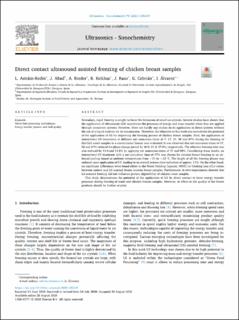| dc.contributor.author | Astráin-Redín, L. | |
| dc.contributor.author | Abad, J. | |
| dc.contributor.author | Rieder, Anne | |
| dc.contributor.author | Kirkhus, Bente | |
| dc.contributor.author | Raso, J. | |
| dc.contributor.author | Cebrián, G. | |
| dc.contributor.author | Álvarez, I. | |
| dc.date.accessioned | 2021-04-21T08:34:53Z | |
| dc.date.available | 2021-04-21T08:34:53Z | |
| dc.date.created | 2020-09-22T15:17:49Z | |
| dc.date.issued | 2021 | |
| dc.identifier.issn | 1350-4177 | |
| dc.identifier.uri | https://hdl.handle.net/11250/2738797 | |
| dc.description.abstract | Nowadays, rapid freezing is sought to favor the formation of small ice crystals. Several studies have shown that the application of ultrasounds (US) accelerates the processes of energy and mass transfer when they are applied through immersion systems. However, there are hardly any studies on its application in direct systems without the use of a liquid medium for its transmission. Therefore, the objective of this work was to evaluate the potential of the application of US for improving the freezing process of chicken breast samples. First, the application of intermittent US treatments at different net sonication times of 7, 17, 37, 50 and 67% during the freezing of distilled water samples in a conventional freezer was evaluated. It was observed that net sonication times of 37, 50 and 67% reduced the phase change period by 30.0, 21.4, 27.0%, respectively. The effective freezing time was also reduced by 12.4 and 12.8% by applying net sonication times of 37 and 50%. Considering these results, an intermittent US treatment with a net sonication time of 37% was chosen for chicken breast freezing in an airforced cooling tunnel at ambient temperatures from −13 to −22 °C. The length of all the freezing phases was reduced upon application of US, leading to an overall process time reduction of approx. 11%. On the other hand, no significant differences were found either in the Water Holding Capacity (WHC) or Cooking Loss (CL) values between control and US assisted frozen chicken breast samples. Furthermore, in vitro experiments showed that US-assisted freezing did not influence protein digestibility of chicken meat samples. This study demonstrates the potential of the application of US by direct contact to favor energy transfer processes during freezing of water and chicken breasts samples. However, its effect on the quality of the frozen products should be further studied. | |
| dc.language.iso | eng | |
| dc.subject | Energy transfer process and food quality | |
| dc.subject | Energy transfer process and food quality | |
| dc.subject | Novel food processing technologies | |
| dc.subject | Novel food processing technologies | |
| dc.title | Direct contact ultrasound assisted freezing of chicken breast samples | |
| dc.type | Peer reviewed | |
| dc.type | Journal article | |
| dc.description.version | publishedVersion | |
| dc.source.volume | 70 | |
| dc.source.journal | Ultrasonics sonochemistry | |
| dc.identifier.doi | 10.1016/j.ultsonch.2020.105319 | |
| dc.identifier.cristin | 1832206 | |
| dc.relation.project | Norges forskningsråd: 281106 | |
| dc.relation.project | Norges forskningsråd: 262300 | |
| dc.relation.project | Nofima AS: 12307 | |
| dc.relation.project | Nofima AS: 201701 | |
| cristin.ispublished | true | |
| cristin.fulltext | original | |
| cristin.qualitycode | 1 | |
